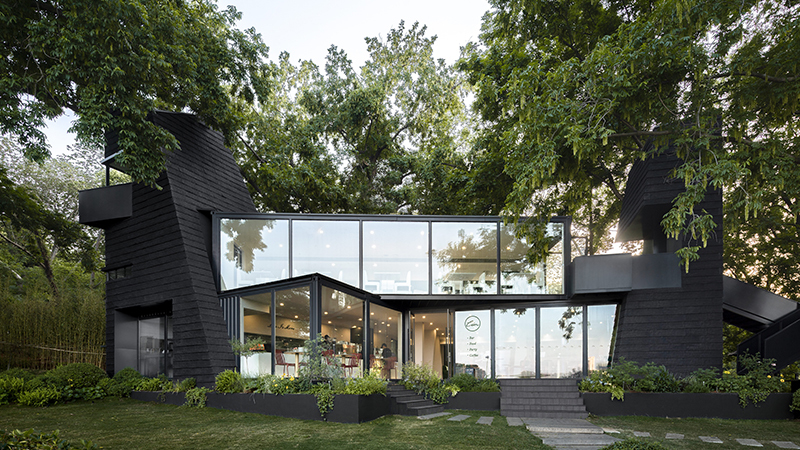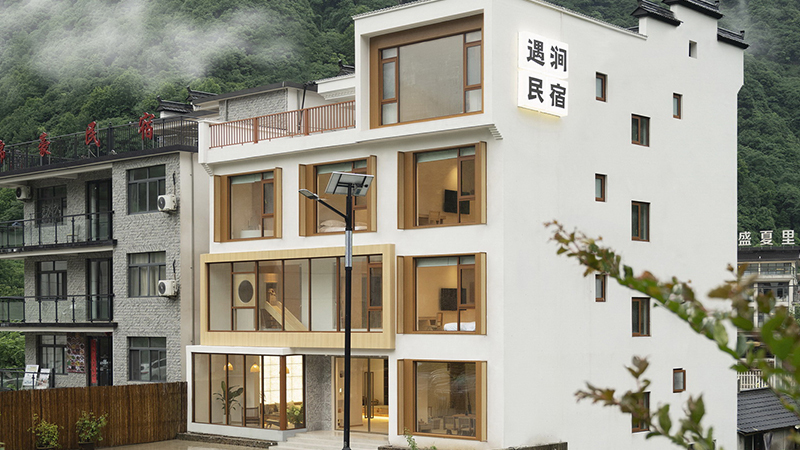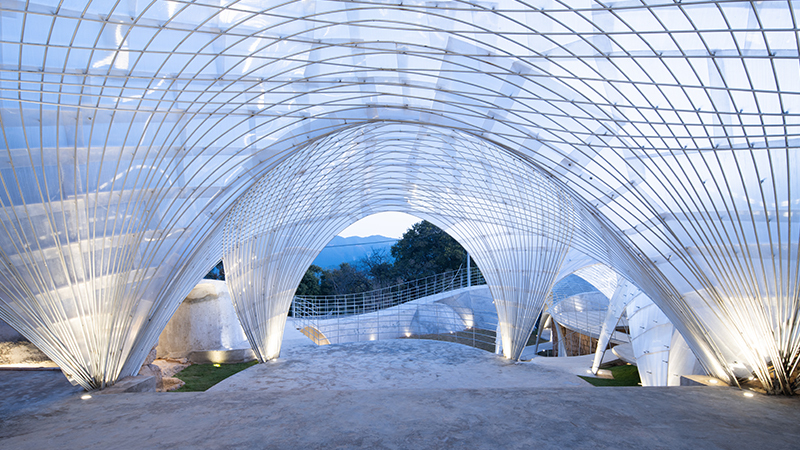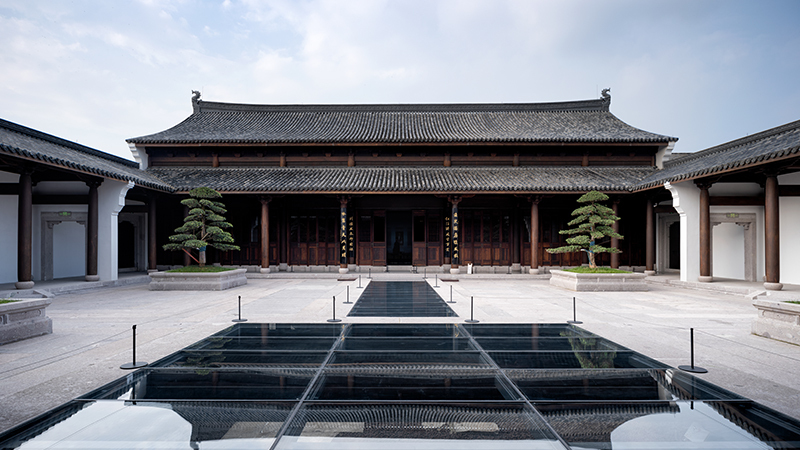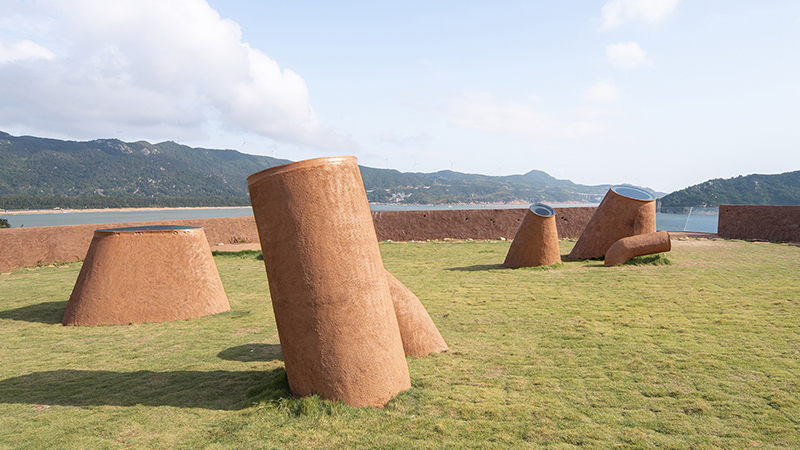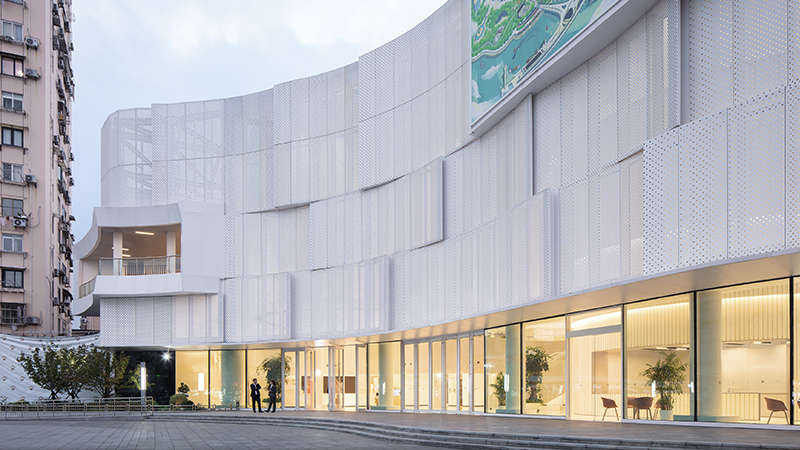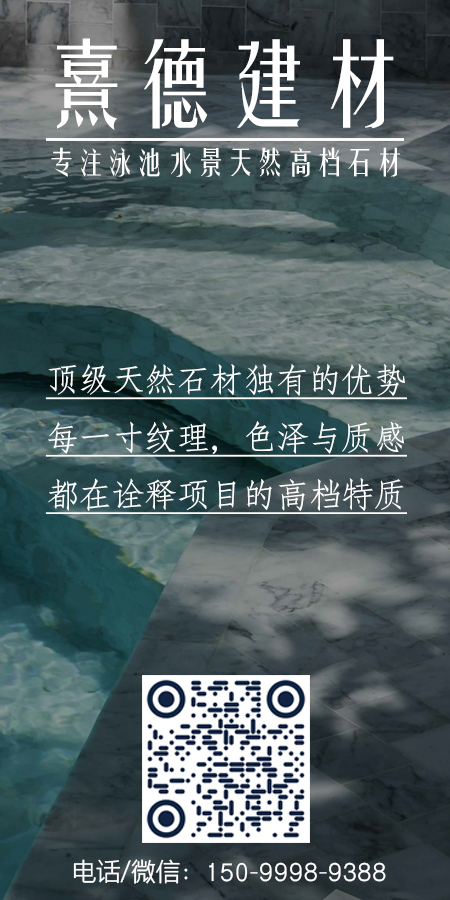东回镇位于云南省普洱市澜沧拉祜族自治县,东回镇为了发展旅游业及特色产业,对下属村落进行整体环境、产业和布局改造,改造后命名为“改新村”,实现了村容村貌和产业发展的大变样。改新村四周大山环绕,有良好的地理气候风貌,当地以咖啡为主要产作物,作为上海黄浦区对口澜沧县的东西协作扶贫项目,计划在此基础上设立咖啡加工工厂并建立配套的咖旅庄园。
Donghui Town is located in Lancang Lahu Autonomous County, Pu'er City, Yunnan Province. In order to develop tourism and characteristic industries, Donghui Town has carried out overall environmental, industrial, and layout transformations of its subordinate villages. After the transformation, the village was renamed "Gaixin Village," achieving a significant change in the village's appearance and industrial development. Gaixin Village is surrounded by mountains with a favorable geographical climate. Local coffee is the main cash crop. As an east-west cooperation poverty alleviation project in which Huangpu District of Shanghai pairs up with Lancang County, it is planned to set up a coffee processing factory and establish a supporting coffee tourism manor on this basis.
▼项目鸟瞰图,Overhead view
▼总平面图,General plan
咖啡研学中心,作为与咖啡产业贯通一二三产的门户建筑,被设立在整个村子民居和工厂交接的主入口处。项目旨在打造一个让人落脚休憩与观光的场所,普及咖啡相关知识、提供咖啡体验、开展咖啡文化交流,同时在此为当地少数民族村民和对咖啡感兴趣的外地人进行咖啡产业相关的培训(采摘、烘培、冲泡等),并在一定程度上补足村子的公共配套基础设施(社区图书馆、卫生间等)。
The Coffee Research and Learning Center, serving as a gateway building that integrates the primary, secondary, and tertiary sectors of the coffee industry, is located at the main entrance where the village's residential area meets the factory. The project aims to create a place for people to rest and sightsee, popularize coffee - related knowledge, offer coffee experiences, and conduct coffee culture exchanges. Meanwhile, it provides coffee - industry - related training (such as picking, roasting, and brewing) for local ethnic minority villagers and outsiders interested in coffee. To some extent, it also supplements the village's public supporting infrastructure (community library, restrooms, etc.).
▼项目鸟瞰图,Overhead view
▼研学活动,Research and study activities
乡村笔记是一个专注于乡村场景的教育服务平台,而研学中心项目也缘起政府引入乡村笔记作为运营方对该建筑进行重新的策划和定位。首次到达现场是十一长假的一个阴雨天,通过曲折蜿蜒的山路到达村落。初具雏形的钢结构框架是前期工厂建设时规划的,在路边就能很明显看到这个构筑,它坐落于整个村落的中心点,周围原始的村落房屋环绕,设计的任务则是在这个框架的基础上重新设计以满足新的功能需求。
The Rural Notes is an educational service platform focused on rural scenes, and the inception of the Study Center project is also rooted in the government's introduction of Rural Notes to re-plan and reposition this building within the factory area. The first visit to the site was on a rainy day during the National Day holiday. We reached the village through winding mountain roads. The rudimentary steel frame structure was planned during the initial phase of factory construction, and it was clearly visible from the roadside. It sits at the center of the entire village, surrounded by primitive village houses. The task of the design was to redesign this framework to meet new functional requirements.
▼施工过程Construction records
云南位于地震带上,建筑抗震等级位9级,那原有的钢结构就不能减只能加,这对建筑的空间和造型就有了一定限制,在和结构专业的几次交流后,通过结合造型的推敲(屋面形式一定程度上延续传统拉祜族民居的形式并进行变化),最终实现结构效能与空间品质的同步提升,我们将平面修改如下:
Since Yunnan is located in an earthquake-prone zone, with a seismic resistance rating of level 9, the existing steel structure can only be strengthened rather than reduced. This imposes certain limitations on the building's spatial layout and design. After several discussions with structural engineering professionals, we have made the following modifications to the floor plan by carefully considering both structural and aesthetic factors:
▼首层平面图,Ground plan
设计之前我们也对场地进行了深刻的思考,咖啡豆从种植和到烘焙出成品是一个漫长的过程,而一杯好的咖啡应该有让人陶醉其中的感觉。因此,我们以咖啡产业全生命周期为设计脉络,构建出沉浸式的空间叙事体系。首层通过半开放复合空间实现建筑与自然融合,可灵活承载主题展览、创意市集等功能,将局部作为咖啡研学使用的室内空间,而中庭的通高空间与二层有功能的联系和空间的体验。二层通过双景观露台构建产业对话,一侧朝向厂区和种植区,一侧朝向进村主路和村落,可通过两侧的室外楼梯到达,室内空间采用柔性隔断设计,通过不同的桌椅形式分割成多样的体验空间。
Before designing, we deeply contemplated the site. The journey from coffee bean cultivation to the final roasted product is a lengthy process, and a good cup of coffee should evoke a sense of enchantment. Therefore, we have constructed an immersive space system around the entire life cycle of the coffee industry. On the first floor, a semi - open composite space is used to integrate the building with nature, which can flexibly accommodate functions such as theme exhibitions and creative markets.Part of it would be used as an indoor space for coffee study activities. The atrium's double-height space would establish a functional connection with the second floor and provide a unique spatial experience.
On the second floor, an industrial dialogue is created through a double landscape terrace. One facing the factory area and plantation, and the other facing the main road into the village. These terraces are accessible via outdoor stairs on both sides. The indoor space is designed with flexible partitions and divided into various experience spaces by different forms of tables and chairs.
▼爆炸图,Diagram
▼项目鸟瞰图,Overhead view
▼项目外观,Exterior of the project
▼室外楼梯,Outdoor stairs
▼研学中心室内,Interior of Research and Study Center
在建筑的二层,是访客在整个场地游览一圈之后的歇脚点,我们可以从多角度感受这个村落的历史背景,点一杯咖啡细细品味,在品味咖啡的同时一侧可以俯看整个工厂厂区,另一侧能看到村子各个角落。
On the second floor of the building, it serves as a resting place for visitors after a tour of the entire site. We can experience the historical background of this village from multiple perspectives. Order a cup of coffee and savor it slowly. While enjoying the coffee, on one side, you can overlook the entire factory area, and on the other side, you can see every corner of the village.
▼二层平面图,the 2nd floor plan
▼项目外观,Exterior of the project
▼研学中心室内,Interior of Research and Study Center
主立面作为在大路上就能看到的展示面,我们希望让他既能和新厂房统一,又需要对村落原有的建筑进行呼应,因此在材料使用上局部采用常见的红砖,所有的金属面都采用银白色,而竖向交通流线的用一条镜面点缀,反射建筑前的村落与自然环境,消解新旧对立的同时让新建的建筑与环境产生对话。
The main facade, visible from the main road, serves as a display surface. We aim for it to harmonize with the new factory building while also resonating with the existing architecture of the village. To achieve this, we use red bricks in certain areas and silver-white colors for all metallic surfaces. Vertical traffic flow lines are adorned with a mirrored strip, reflecting the village buildings in front of the structure, thus, while resolving the opposition between the old and the new, initiating a dialogue between the new building and its surroundings.
▼项目鸟瞰图,Overhead view
▼沿路主立面,The main facade along the road
一层的研学空间四周采用全落地玻璃,可根据活动功能需要来开启或关闭,开启时形成室内外贯通的教育复合空间,实现研学活动与户外场地的功能互动,并在一定程度上预留灵活性可满足不同形式的活动开展(市集、表演等)。
The study space on the ground floor is surrounded by full-length glass panels, which can be opened or closed based on the functional requirements of activities. When opened, the entire study space can extend outdoors, providing a seamless connection between the indoor and outdoor areas.And to a certain extent, leaving some flexibility can meet the needs of different forms of activities (such as markets and performances).
▼项目外观,exterior of the project
▼一层廊道,Corridor on the first floor.
二层主立面室外露台远眺村落风景,纵向贯通历史建筑群轮廓,横向串联生活场景片段,细细感受村落文化和生活气息。
The terrace on the second-floor main facade offers panoramic views of the village. Its vertical alignment frames the silhouette of historical architecture, while horizontal sightlines curate vignettes of daily life. It allows visitors to immerse themselves in the cultural and lifestyle ambiance of the village.
▼项目外观,exterior of the project
▼项目外观,exterior of the project
二层面向厂区和种植区方向采用大面积玻璃的立面,以全景视野构筑起与古村落人文肌理的对话窗口。室内空间创新植入多维几何体块,营造视觉与触觉交融的沉浸式体验动线——游客既可透过落 地窗饱览原生景观与村落风情,又能在移步易景中见证咖啡豆从果实到杯中的生命之旅,感受自然馈赠与人文智慧的完美交响。
On the second floor, the facade facing the factory area and the planting area features large - scale glass, creating a dialogue window with the humanistic texture of the ancient village through a panoramic view. In the interior space, multi - dimensional geometric blocks are innovatively incorporated to create an immersive experience route that combines visual and tactile sensations. Tourists can not only enjoy the original scenery and the charm of the village through the floor - to - ceiling windows, but also witness the life journey of coffee beans from fruit to cup as they move around, feeling the perfect symphony of nature's gifts and human wisdom.
▼项目外观,exterior of the project
▼项目外观,exterior of the project
结合天窗设置了沙发和卡座区,丰富不同的体验空间的同时也让人有闲适,惬意的感受。
By incorporating skylights, we've created a cozy seating area with sofas and booths. This not only enriches the diverse experience spaces but also allows visitors to relax and unwind in comfort and leisure.
▼研学中心室内(施工中),Interior of Research and Study Center
▼研学中心室内,Interior of Research and Study Center
改新村咖啡研学中心是乡村振兴中产业与空间融合的创新实践,通过建筑空间与生产场景的有机互动,搭建起城乡文化交流的实体平台,用全景玻璃界面、灵活隔断和互动体验路线,将咖啡生产流程转化为沉浸式教育场景。设计中通过红砖与镜面的材料对话,以及生产展示与村落景观的视线渗透,在保留乡土记忆的同时构建起城乡文化交流平台,为乡村产业升级提供了可复制的空间转型样本,让曾经无人问津的古村焕发生机。
The Gaixin Village Coffee Research and Learning Center is an innovative practice of integrating industry and space in rural revitalization. Through the organic interaction between the architectural space and the production scenario, it builds a physical platform for urban - rural cultural exchange. With panoramic glass interfaces, flexible partitions and interactive experience routes, it transforms the coffee production process into an immersive educational scenario. In the design, through the material dialogue between red bricks and mirrors and the visual penetration between production display and village landscape, while preserving rural memories, it constructs a platform for urban - rural cultural exchange, providing a replicable space transformation model for rural industrial upgrading and bringing vitality to the once - neglected ancient village.
▼项目鸟瞰图,Overhead view
▼方案模型,scheme model
▼项目鸟瞰图,Overhead view
▼项目外观,exterior of the project
▼项目外观,exterior of the project
▼剖透视图,Sectional perspective view
项目名称:乡村振兴咖旅庄园研学中心
业态规划:上海乡村笔记教育科技有限公司
设计单位:华建集团建筑装饰环境设计研究院,平介设计
施工图设计:云南玖星建筑勘察设计有限公司
公司网站:https://www.parallect-design.com
联系邮箱:info@parallect-design.com
建筑面积:2000㎡
项目设计&完成年份:2023,10;2024,05
设计团队:
平介设计:李宗键,王蕴伟,田欣怡
苏州大学:杨楠,肖湘东
摄影版权:王一翔
业主:澜沧县东回镇改新村,上海乡村笔记教育科技有限公司
项目地点:云南省普洱市澜沧县东回镇改新村
Project Name: Rural Revitalization Coffee Tourism Manor Research and Study Center
Planning: Beyond The City
Designer: Huajian Group Architectural Decoration Environment Design and Research Institute, Parallect Design
Construction Drawing Design: Yunnan Nine Stars Architectural Survey and Design Co.
Company website: https://www.parallect-design.com
Contact Email: info@parallect-design.com
Building Area: 2000 square meters
Design year: 2023, 10; 2024, 05
Design Team:
Parallect Design:Li Zongji,Wang Yunwei, Tian Xinyin
Soochow University: Yang Nan, Xiao Xiangdong
Photographer: Wang Yixiang
Client: Gaixin Village, Donghui Town, Lancang County; Beyond The City
Location: Gaixin Village, Donghui Town, Lancang County, Pu'er City, Yunnan Province, China
更新日期:2025-08-27 16:04:37
非常感谢 平介设计 带来的精彩项目, 查阅更多Appreciations towards Parallect Design for sharing wonderful work on hhlloo. Click to see more works!






























